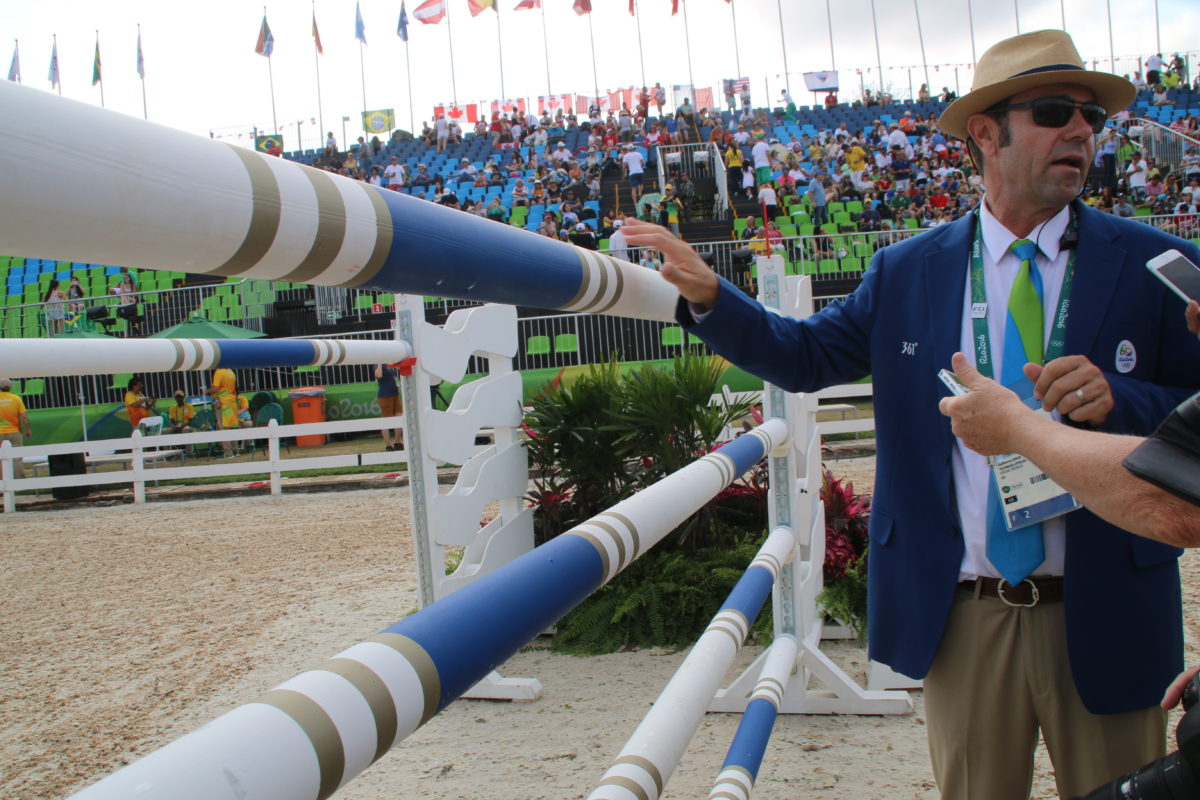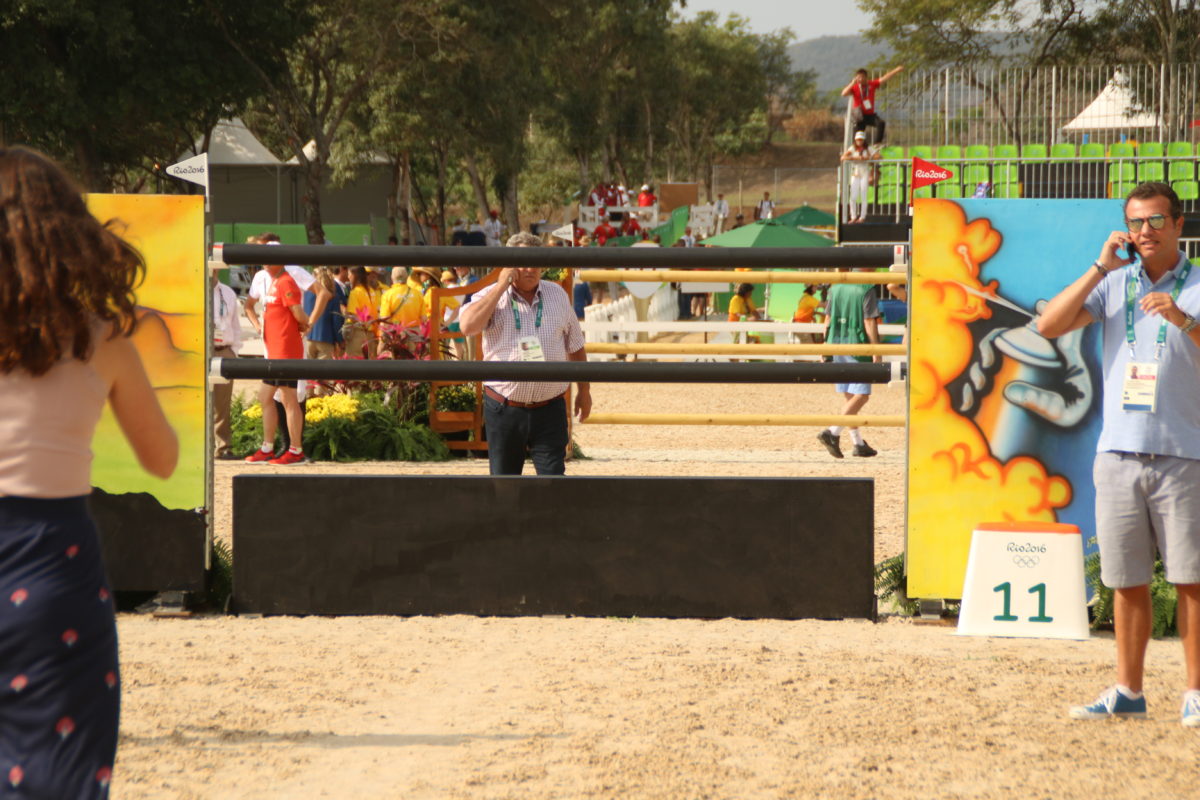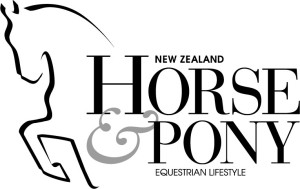 Designer Guilherme Jorge explained his course to journalists today, before the first of the two rounds which will decide the winners of the individual jumping medals.
Designer Guilherme Jorge explained his course to journalists today, before the first of the two rounds which will decide the winners of the individual jumping medals.
He began by saying that the level of competitors was very high and there were limitations as to what he could build: only 12 jumps can be used in the first round, including a double and a treble, and only 10 in the second, again with a double and treble. He therefore starts this course with a strong fence one.
 It is 1.50 high and 1.50 wide, followed by a big gallop to the second fence, which is the beginning of the first line (fences 2, 3, 4a and 4b). The time, he says, is not as hard as it was in the teams jumping; perhaps one second slower.
It is 1.50 high and 1.50 wide, followed by a big gallop to the second fence, which is the beginning of the first line (fences 2, 3, 4a and 4b). The time, he says, is not as hard as it was in the teams jumping; perhaps one second slower.
 Fence 2 is a delicate one and solid-coloured rails make it more difficult, as there are fewer reference points for the horse to focus on. It is 1.60 high, and is followed by five forward strides (23.20m) to fence 3. Guilherme wants riders to start on a good rhythm.
Fence 2 is a delicate one and solid-coloured rails make it more difficult, as there are fewer reference points for the horse to focus on. It is 1.60 high, and is followed by five forward strides (23.20m) to fence 3. Guilherme wants riders to start on a good rhythm.
 Fence 3 is 1.53 high and 1.70 wide, followed by a bending seven strides which the rider needs control for, as they will be short. Fence 4a is 1.58m with a liverpool.
Fence 3 is 1.53 high and 1.70 wide, followed by a bending seven strides which the rider needs control for, as they will be short. Fence 4a is 1.58m with a liverpool.
 It’s an eight-metre forward stride to 4b, which is 1.55 high and 1.60 wide, then there’s a little break as the turn is negotiated, with the option of going inside or outside the flowers.
It’s an eight-metre forward stride to 4b, which is 1.55 high and 1.60 wide, then there’s a little break as the turn is negotiated, with the option of going inside or outside the flowers.
 Fence 5 is the water jump, 1.30 wide. There is no point of reference with a related fence, and this could be tricky for some as they have to ride off their eye.
Fence 5 is the water jump, 1.30 wide. There is no point of reference with a related fence, and this could be tricky for some as they have to ride off their eye.
Fence 6 is skinny and delicate, 1.60 high. The pinstripe paint is again more complicated for the horses to perceive: a way of making the fence harder without increasing the height.
 The treble is on a slight incline and 7a (1.60 wide and 1.53 high) to 7b is 7.8 metres, so a forward stride is required. 7b is 1.56 high and 1.20 wide but will ride a little bigger with the uphill element to consider. Riders really need to keep the horse’s attention. Then it’s 11 metres – two short strides – slightly downill to 7c, facing the exit, which could be distracting.
The treble is on a slight incline and 7a (1.60 wide and 1.53 high) to 7b is 7.8 metres, so a forward stride is required. 7b is 1.56 high and 1.20 wide but will ride a little bigger with the uphill element to consider. Riders really need to keep the horse’s attention. Then it’s 11 metres – two short strides – slightly downill to 7c, facing the exit, which could be distracting.
 Riders can shave a bit off the corner to approach Fence 8, then it’s about seven strides to fence 9, an oxer of 1.50 high and 1.70 wide with water underneath.
Riders can shave a bit off the corner to approach Fence 8, then it’s about seven strides to fence 9, an oxer of 1.50 high and 1.70 wide with water underneath.

 The last line is sure to be a challenge. Fence 10 is 1.53 high and 1.80 wide (the widest on the course), with four short strides (20 metres) to the next fence, a delicate 1.60 vertical with a black wall underneath, which could attract the horse’s attention.
The last line is sure to be a challenge. Fence 10 is 1.53 high and 1.80 wide (the widest on the course), with four short strides (20 metres) to the next fence, a delicate 1.60 vertical with a black wall underneath, which could attract the horse’s attention.
 There are then four very short strides to the last fence, an airy looking 1.60m upright.
There are then four very short strides to the last fence, an airy looking 1.60m upright.
 Guilherme says that building this course has been a big challenge. He wants the right number of clear rounds without overfacing the horses, and he wants all the horses to leave Rio in good spirits.
Guilherme says that building this course has been a big challenge. He wants the right number of clear rounds without overfacing the horses, and he wants all the horses to leave Rio in good spirits.








